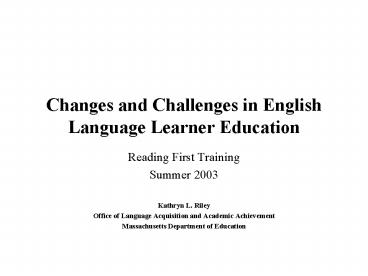Changes and Challenges in English Language Learner Education - PowerPoint PPT Presentation
1 / 6
Title:
Changes and Challenges in English Language Learner Education
Description:
Changes and Challenges in English Language Learner Education. Reading First Training ... significant challenge to all of us, and particularly those who teach ... – PowerPoint PPT presentation
Number of Views:52
Avg rating:3.0/5.0
Title: Changes and Challenges in English Language Learner Education
1
Changes and Challenges in English Language
Learner Education
- Reading First Training
- Summer 2003
- Kathryn L. Riley
- Office of Language Acquisition and Academic
Achievement - Massachusetts Department of Education
2
Who are ELLs in Massachusetts?
- 51,546 LEP students reported October 2002. This
data represent a 10 increase over October 2001. - Forty-three percent, or 26,527 of those LEP
students were in grades PK-3. - Approximately 80 speak Spanish or Portuguese as
a first language. - Immigrant families are increasing settling in
suburban and rural districts, so LEP numbers are
increasing in those districts. - Increasing number of older students entering
school with little or no prior schooling and
therefore little or no L1 literacy . These
students are often referred to as Limited Formal
Schooling (LFS) students.
3
Why is the education of ELLs such an important
topic at this time?
- Education reform in Mass competency
determination - NCLB
- Goal 1.3 - Grade 3 reading proficiency
- Goal 2 - English language proficiency and
academic achievement for LEP students - Accountability system
- New state law
- TBE required under old law (transitional
bilingual education) - SEI required under new law (sheltered English
immersion) - Result a significant challenge to all of us,
and particularly those who teach reading
4
What are some fundamental considerations when
thinking about learning to read in a second
language?
- Different than learning to read in a language you
already speak - Research has shown a strong relationship between
English oral language proficiency and English
literacy. What are the instructional
implications? No consensus on this question. - Different reading backgrounds of ELLs. Some
children come with no literacy. Some come with
grade-level literacy in their first language. - Questions???
5
What is MADOE doing to improve the development of
English language proficiency and academic
achievement of LEP students?
- A. ELP Benchmarks and Outcomes - (available at
ELL homepage www.doe.mass.edu/ell ) - B. MELA-O statewide training
- C. English Proficiency Assessment (EPA) in
reading and writing in development - D. Emerging districts initiative - summer
- E. Initiative for larger districts beginning in
fall
6
What can you do?
- A. Get the ELP Benchmarks and Outcomes, and
participate in development of ELL curriculum in
your district. - B. Participate in MELA-O training.
- C. Participate in SIOP or other training offered
in your district.































